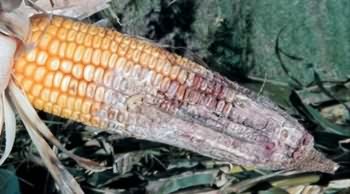Diseases
Fusarium moniliforme Scheld. - Fusarium Ear Rot
Systematic position.
Class Ascomycota, subclass Sordariomycetidae, order Hypocreales, family Nectriaceae, genus Fusarium.Biological group.
Facultative parasite.Morphology and biology.
Pale-pink mold appears on the surface of ears at the end of the milky stage or in the beginning of waxy stage. If the mold is thick, the grains are destroyed. 15-30 destroyed grains can be present on one ear. The mold of F. moniliforme consists of mycelium and micro-conidia of fungi. The size of micro-conidia is 4.3.19.0 x 1.5.4.5 microns. Macro-conidia appear rarely. They are straight or slightly curved, their length is 30.58 microns, and their width is 2.7.3.6 microns. They have 3-5 septa. Infected seeds and corn residues are sources of the infection. In spring the micro-conidia grow out and infect plants. On residues the fungi can form the teleomorth Gibberella fujikuroi. Ascospores of G. fujikuroi can also be the source of infection. Insect damaged grains are particularly prone to infection of the fungi.Distribution.
Fusarium Ear Rot is the most common fungal disease on ears of corn, especially in moist regions. In these areas the disease affects 50-60% of corn sowings. The disease is most harmful in the Northern Caucasus, in Central regions of the European part of Russia, in Siberia, Altai Territory, in the Far East, Ukraine, Georgia and Byelorussia.Ecology.
The optimum temperature for fungus development is 30.C, the minimum is 10-14.C, and maximum is 35-39.C. High levels of humidity during the period of maturation and harvesting of corn increases the number of infected ears.Economic significance.
Fusarium Ear Rot reduces yield and quality of the corn harvest. When disease development is high more than 60% of ears are affected. The disease can continue its development during storage of ears under the conditions of high humidity and insufficient aeration. F. moniliforme can produce mycotoxins known as fumonisins. These toxins are carcinogenic for people and animals. To protect corn from the disease the following measures are recommended: removal of infected ears; autumn plowing and removal of corn residues; treatment of grain with fungicides; protection of corn from insects that damage ears; storage of ears under the best possible conditions; control for mycotoxins before putting the grain in storage.Reference citations:
Geshele E.E., Vinogradova N.I. 1957. Corn diseases in West Siberia and their control. Proc. of Omsk Agricultural Institute, 22(1): 117-124. (In Russian)Ivashchenko V.G., Shipilova N.P., Sotchenko E.F. 2000. The most damaging disease of seeds and ears of corn. Agro XXI, 7: 6-7. (In Russian)
Kalashnikov K.Ya., Shapiro I.D. 1962. Pests and diseases of corn. Leningrad: Selkhozgiz. 189 p. (In Russian)
Nemlienko F.E. 1957. Diseases of maize. Moscow: Selkhozgiz. 230 p. (In Russian)
Rheeder J.P., Marasas W.F.O., Vismer H.F. 2002. Production of fumanisin analogs by Fusarium species. Applied and Environmental Microbiology, 68: 2101-2105.
© Levitin M.M.


